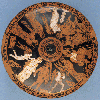Images of Women and
Goddesses
From the Museum's Ancient
Greek World Collection
 Silver Tetradrachm
Silver Tetradrachm
ca. 449-410 BC
Athens
29-126-404
The head of Athena is on the obverse, an owl with olive branch on the
reverse. The goddess (in Greek, Athena) is a punning reference to the
city (in Greek, Athenai) that honored her as its chief protective
deity. The owl as Athena's favorite bird and the olive, which was one
of the city's most lucrative exports, came in time to stand for
Athens throughout the Mediterranean world.
Dia. 24.0 mm. Obverse: Photo courtesy Registrar's Office, Univ.
of Pennsylvania Museum.
Reverse: Photo courtesy Donald White. (large
version)
 Marble Head of Athena
Marble Head of Athena
2nd century BC
Purchased in Cairo
MS 4026
Athena was the daughter of Zeus and originally a Mycenaean palace
goddess. Her function later expanded to include the roles of guardian
of cities, war goddess, patroness of arts and crafts, and promoter of
wisdom. She is always shown modestly clothed and often armed. The owl
is her special bird. The back of the sculpture seems deliberately cut
and at least one rectangular hole looks ancient. This suggests that
the head once formed part of a relief. Given its size, the unfinished
appearance of the top of the helmet, and the foreshortening evident
in its execution, the head may have been part of a sculpted pediment
group, perhaps originally set up in Alexandria.
H. 30.0; W. 24.0; Th. 16.0 cm. Photo courtesy Mediterranean
Section, Univ. of Pennsylvania Museum. (large
version)
 Attic Red Figure Pyxis
Attic Red Figure Pyxis
ca. 400-390 BC
By the Meleager Painter
MS 5462
Heracles and Hebe's wedding in the presence of the gods on Mt.
Olympus. The lid of the pyxis shows Heracles leading Hebe to his
house, while an Eros or Cupid figure carries a marriage torch in
front of the wedded couple. Hebe is dressed in a white and gold
chiton and himation and wears a wedding veil which another Eros
adjusts. A goddess lights the scene with a pair of torches. Athena
and Zeus sit enthroned, while Hera leans intimately against Zeus's
shoulder. A third Eros reclines against Zeus's throne next to a
high-stemmed censer for burning incense. Behind the Eros is a low,
footed chest, probably a wedding gift. Two women carry a jewel box
for the bride and a vessel containing water for her bridal bath.
H. 9.0; Dia. 21.8 cm. Photo courtesy Public Information Office,
Univ. of Pennsylvania Museum. (large
version)
 South
Italian Greek Terracotta Votive Figurine
South
Italian Greek Terracotta Votive Figurine
ca. 450-425 BC
MS 1857
Either a Demeter or Persephone figurine or a priestess. The low polos
headdress is associated with both, but the apron suggests a
priestess. Carrying a piglet, she holds aloft a circular box or
kanoun. Inexpensive terracottas depicting female subjects turn up in
very large quantities in sanctuaries dedicated to female goddesses
throughout the Greek world. Women were especially active in all
aspects of Demeter's cult.
H. 32.5; W. 13.0; Th. 8.0 cm. UM neg. S8-55808. (large
version)
 Attic Black Figure Amphora
Attic Black Figure Amphora
ca. 530-525 BC
In the manner of the Lysippides Painter
MS 5467
Both sides portray scenes of mythological battle, which symbolize the
Greek preoccupation with struggle as well as their love for detailed
battle narrations. Such scenes are a hallmark of Archaic art. Here,
Heracles (at the left) fights with two Amazons, a race of female
warriors thought to live on the fringes of the civilized world.
H. 41.0; Dia. 28.0 cm. Photo by Maria Daniels for the Perseus
Project. (larger
version)
 Italic Low-Footed Red Figure Bowl with High Handles
Italic Low-Footed Red Figure Bowl with High Handles
4th century BC
On loan, Philadelphia Museum of Art
L-64-23 detail
The most common toilet article appearing on vases is the mirror,
usually made of polished silver or bronze. These and a wide variety
of cosmetic implements are often excavated in tombs, sanctuaries
dedicated to female divinities, and in the domestic quarters of
ancient towns.
Photo courtesy Mediterranean Section, Univ. of Pennsylvania
Museum. (large
version)
 Western Asia Minor Marble Funeral Stele
Western Asia Minor Marble Funeral Stele
Hellenistic/1st century BC
MS 4023
A man reclines in an arched niche on a tall dining couch or
kline. Leaning on his left elbow supported by a pillow, he
holds aloft a funeral wreath. A woman, probably his wife, is shown in
an attitude of contemplation with her cloak or himation
pulled over her head. The three-legged table is laden with food. Male
and female servants, done in a smaller scale in keeping with their
lesser status, fill out the remainder of this melancholy scene. The
inscription across the architrave reads "Worthy Menemachos, son of
Diphilos, farewell."
H. 70.5; W. 47.0; Th. 8.5 cm. UM neg. NC35-3317. (large
version)
 Attic White Ground Lekythos
Attic White Ground Lekythos
Late 5th century BC
Attica
MS 4082
A girl seated on a chair with a wreath in her hands; her wool basket
is set to the right. The undulating snake, which appears above, is
traditionally associated with the dead from the Geometric period
on.
H. 13.4; Dia. 5.0 cm. Photo by Maria Daniels for the Perseus
Project. (large
version)
The Ancient Greek World Index
 Silver Tetradrachm
Silver Tetradrachm Marble Head of Athena
Marble Head of Athena Attic Red Figure Pyxis
Attic Red Figure Pyxis South
Italian Greek Terracotta Votive Figurine
South
Italian Greek Terracotta Votive Figurine Attic Black Figure Amphora
Attic Black Figure Amphora Italic Low-Footed Red Figure Bowl with High Handles
Italic Low-Footed Red Figure Bowl with High Handles Western Asia Minor Marble Funeral Stele
Western Asia Minor Marble Funeral Stele